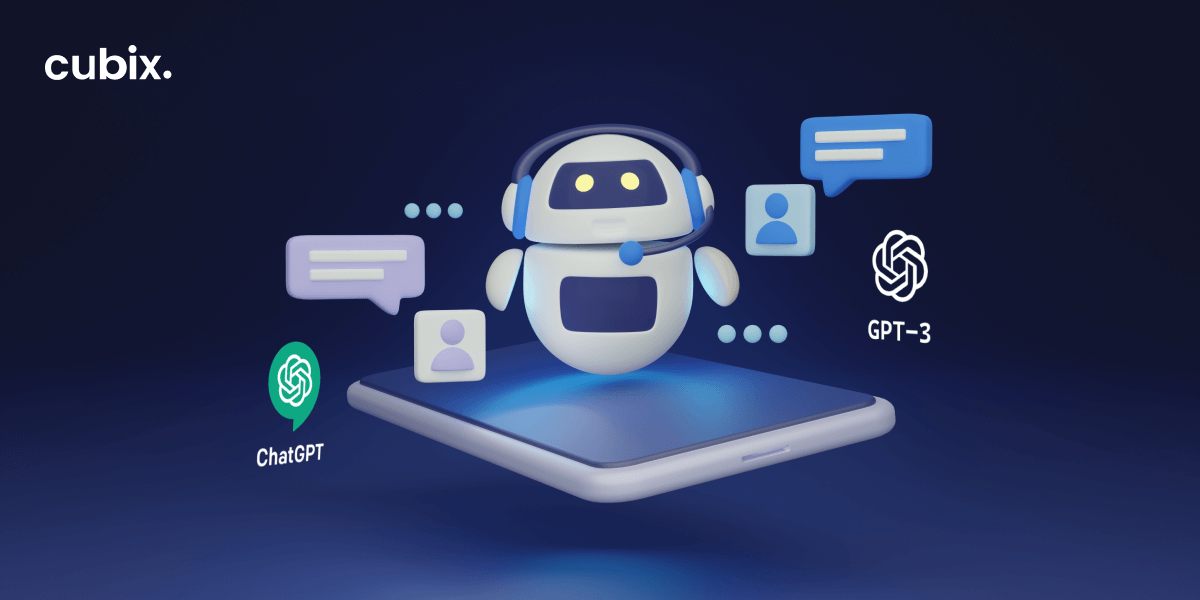Not too long ago, people thought Google would always be the go-to source for all kinds of info. It was never capable of delivering everything. However, it was perhaps the only source that incrementally improved, eventually emerging with a fabulous array of tools and resources for individuals and businesses to benefit from.
All that Google achieved now seems like a proverbial stoneage in the face of the OpenAI algorithm and its different models. ChatGPT, for example, is an unprecedented worry for a robust entity like Google.
To findout why this is the case, let’s review what this model of the OpenAI algorithm is.
What is ChatGPT and Chat GPT-3?
ChatGPT (Generative Pre-training Transformer) and GPT-3 (Generative Pre-training Transformer 3) are enormous language models built by OpenAI: a research firm committed to the advancement of artificial intelligence (AI). A group of businessmen and researchers, including Elon Musk and Sam Altman, established the private firm OpenAI in 2015.
The models, ChatGPT and GPT-3 are owned by OpenAI and made accessible to scholars, programmers, and other concerned parties through a slew of platforms and APIs (Application Programming Interfaces).
Several apps employ ChatGPT and GPT-3, regarded as some of the most cutting-edge language models in recent times. They have been utilized in numerous research programs and industrial applications and have drawn considerable media and AI community interest. Let us dive deeper to understand the ChatGPT vs. GPT-3 differences further.
What is ChatGPT?
In essence, OpenAI's ChatGPT chat-based generative pre-trained transformer, released by Open AI at the end of November 2022 and intended to carry conversations with people, is a variant of the well-known GPT-3 language-generation model. According to the OpenAI overview of the language model, some of its characteristics include responding to follow-up queries, opposing fallacious arguments, denying unnecessary user requests, and even owning to erroneous actions.
A vast quantity of text data was used to train ChatGPT. As a result, it acquired the ability to spot patterns that enable it to generate text in various writing styles. Although OpenAI won't disclose data used to train ChatGPT, the business claims it generally used Wikipedia, archival books, and web crawls.
It is an AI product that has been taught how to recognize patterns in substantial concentrations of text taken from the internet and then further trained with the aid of humans to provide more helpful, better conversation. As OpenAI cautions, the answers you receive seem logical and authoritative, but they could also be completely incorrect.
See More: Conquer New Horizons With Our AI Development Service
How to access ChatGPT?
To access ChatGPT and use it to create chatbot replies for your apps, utilize the OpenAI API. To accomplish this, you must register an account for an API key and adhere to OpenAI's API access guidelines.
Use one of the GPT-compatible chatbot systems, such as Botpress or Replika. These platforms offer several features and tools for constructing and maintaining your chatbot and let you use GPT to design and personalize your chatbot.
One of the ChatGPT libraries that are readily accessible, such as transformers or Pytorch-transformers, can be used to implement ChatGPT and produce chatbot replies in your applications. This approach is good to go for experienced users and will need some programming expertise.
How does ChatGPT work?
To optimize ChatGPT, the inventors used both supervised learning and reinforcement learning; hence, the reinforcement learning aspect distinguishes ChatGPT from other similar systems. Furthermore, to reduce unpleasant, fake, or misleading outputs, the creators apply a specific approach called Reinforcement Learning from Human Feedback (RLHF).
These capabilities may appear very underwhelming when considering chatbots for tasks like customer service. However, the distinction between ChatGPT and other chatbots is that it can answer immediately to an inquiry and engage in conversation much as a human could.
Pros and Cons of ChatGPT:
Although ChatGPT is a robust language model that can generate text and code, it has numerous limitations and issues.
Pros:
Cons:
Read More: Potent technologies in an unprecedented world: Create an app using OpenAI.
What is GPT-3?
The GPT-3 (Generative Pre-trained Transformer 3) is a language prediction model built on deep learning. Deep learning is a member of a broader family of machine learning methods that use artificial neural networks.
On June 11, 2018, the OpenAI website posted the first iteration of the GPT as a research paper. It demonstrated the language prediction model's capacity to incorporate global information. It was suggested that a language model must first be learned from unlabeled data before being improved by practice on real-world NLP (Natural Language Processing) tasks, including text categorization, sentiment classification, and word segmentation.
GPT-3 was released as a beta version on June 11, 2020. GPT-3's public version can store 175 billion ML parameters of data. Comparison to 1.5 billion parameters in GPT-2 demonstrates the immense power of GPT-3. Microsoft and OpenAI established a multi-year collaboration on September 22, 2020, and they agreed to license GPT-3 solely to Microsoft for their products and services.
Modern language processing AI model GPT-3 can produce human-like text with a broad range of uses, including text generation for chatbots, language modeling, and language translation.
How to access the GPT-3?
The marketing of GPT-3 as the OpenAI API has prevented many people from giving it a try. It seems like getting started with this will take a great deal of work. But having access to the API also gives you access to the GPT-3 playground, a very user-friendly interface. You just have to open a text box, write your phrases within, and then click the "execute" button and this is it. Three requirements must be met in order to use GPT-3 for free: an email address, a phone number that can receive verification messages, and residency in one of the listed nations and regions.
Read More: Trending Ideas and Use Cases for OpenAI GPT-3
How does GPT-3 work?
GPT-3 processes data using neural networks in order to identify correlations. A language model, such as GPT-3, is statistical software that forecasts the expected arrangement of words. GPT-3 has witnessed millions of dialogues and has been trained on vast datasets (from sources like Common Crawl, Wikipedia, and others). It can determine which word (or even character) should follow next in relation to the words surrounding it.
GPT-3 is exceptional as it can react intelligently to very minimal input. This is referred to as "few-shot learning" because after lengthy training on billions of parameters, it now only requires a few numbers of cues or examples to carry out the particular task you want.
Instead of being downloaded, GPT-3 operates as a cloud-based LMaaS (language-model-as-a-service). By turning GPT-3 into an API, OpenAI aims to more securely limit access and include rollback features in the model to counter cyber breaches.
Pros and Cons of GPT-3:
Although the GPT-3 software is indeed terrific, that does not imply that it is infallible. So, let's have a quick peek at its pros and cons:
Pros:
Cons:
Read More: OpenAI vs DeepMind: Key Differences Explained
ChatGPT vs. GPT-3?
The artificial intelligence models, ChatGPT and GPT-3, were created by OpenAI. Both language models predict the upcoming word in a sequence based on the context of the phrases that come before it to produce content that resembles human speech.
The size and capability of ChatGPT and GPT-3 are the key distinctions. GPT-3, with a capacity of 175 billion parameters compared to ChatGPT's 1.5 billion parameters, is more robust and equipped to handle a larger range of activities and text-generating styles.
ChatGPT and GPT-3 may be used to build chatbots that can converse with users in a natural way. They can also be employed for a wide range of additional jobs, including content production, language translation, and summarization. However, it is crucial to keep in mind that neither ChatGPT nor GPT-3 are ideal alternatives for human intellect and may commit errors or provide incorrect or inappropriate output.
Are ChatGPT and GPT-3 a threat to search engines like Google:
GPT models might be a financial catastrophe for Google as Google crawls through thousands of search result pages. In contrast, GPT models have been trained on millions of web pages to gather knowledge that was published on the internet before late 2021, as well as the ability to converse in a human-like manner. Additionally, ChatGPT provides an instant answer that eliminates the need to go across other websites.
However, a search engine like Google employs algorithms to browse the web, index web pages, and respond to user requests with search results. At the same time, some industry experts claim that GPT models are not intended to respond to user requests with search results, as they lack the capacity to index or crawl the internet.
Therefore, this does not constitute a threat to search engines like Google, as the quality and relevance of the information created by ChatGPT and GPT-3 would still need to be analyzed by a search engine's ranking algorithms in order to establish its merit and ranking in search results. Moreover, GPT models are tools that may be used in conjunction with search engines to improve user experience and the caliber of search results.
Read More: What is DALL-E 2 and What Can You Do with it?
Future of ChatGPT and GPT-3:
The integration of these models with other artificial intelligence (AI) technologies, such as natural language processing (NLP) and machine learning (ML), is among the potential avenues for the development of ChatGPT and GPT-3. This could result in developing more complex language models that are smart and capable of performing more difficult jobs and producing even more human-like content.
It's also expected that ChatGPT and GPT-3 will get exposure to a number of industries like business, healthcare, and education in the future. The use of cutting-edge language modeling has the potential to influence and enhance a number of sectors and applications substantially; hence the dilemma of ChatGPT vs GPT-3 appears to be blooming bright.
If you want to gain a new perspective on your project based on AI, get in touch with us today!

